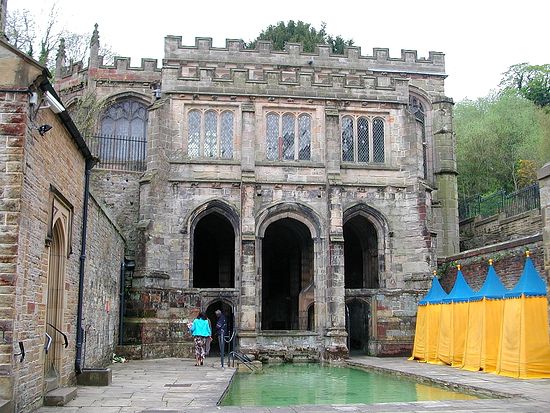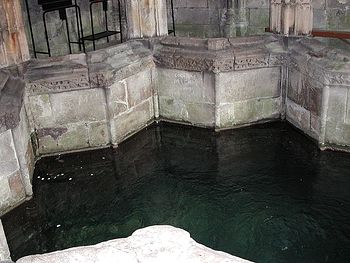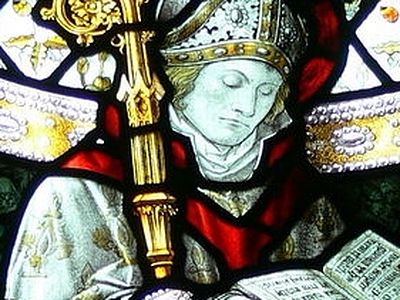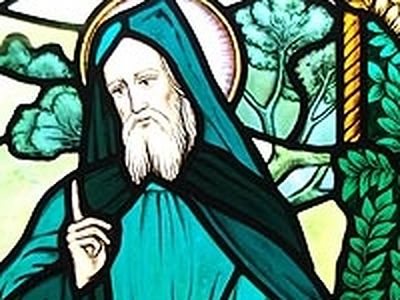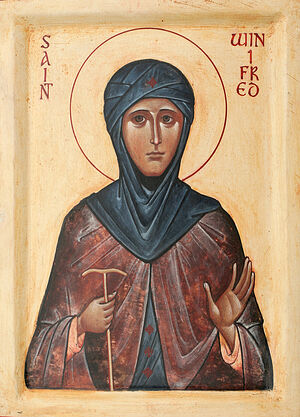 Icon of St. Winifred, painted by a modern Orthodox iconographer.
Icon of St. Winifred, painted by a modern Orthodox iconographer.
One Sunday, while St. Beuno was serving the Liturgy at the church, Winifred was alone in her house. A prince named Caradog was riding by, and stopped at the house to ask for a drink of water. Winifred was very beautiful, and Caradog was stricken with the desire to have her in marriage. The maiden’s resolve to preserve her virginity and become a nun was unshakeable, however, so the prince attempted to take her by force. Winifred struggled free and ran toward the church, but Caradog soon caught up with her on his horse. Out of anger at the refusal, he struck off her head with his sword. Her severed head rolled down the hillside to the churchyard. When her uncle and the congregation—which probably included Winifred’s other kin—saw what had happened, they were horrified. The wicked Caradog fell dead on the spot. (Other historical sources say that Caradog was killed by Winifred’s brother, Owain, as an act of revenge.)
A spring of healing water sprang forth at the place where St. Winifred’s head fell. St. Beuno took Winifred’ head and replaced it to her body, then prayed to God that she be restored whole. By St. Beuno’s prayers, Winifred came back to life. The two sat on a rock which was later named, “St. Beuno’s rock,” and her uncle told her that anyone seeking help through her prayers at that spot would find it. A red mark remained around her neck, as a remnant of her miraculous restoration.
With her parents’ blessing, Winifred soon received the monastic tonsure at her uncle’s hand. St. Beuno advised Winfred to remain at that church to live the monastic life, which she did, eventually gathering around her eleven honorable virgins, and instructing them in the Christian faith. St. Beuno himself became a missionary, traveling west to Ireland.
St. Winifred made a pilgrimage to Rome, and was greatly influenced by the order of monastic life there. When she returned home, she called a synod known as the “Synod of Winifred,” attended by other Christian ascetics of Wales, Dumnonia, and the North. The common ascetic practice in Wales at the time was the eremitic life. At the synod, all agreed that the safety of the coenobitic life she led was preferable to the solitary life. Thus, after seven years in Abeluyc, Winifred decided to go out and help establish other coenobitic communities. It is said that two hermits she approached with the idea, Sts. Diheufyr and Sadwrn, were not interested in what seemed to them an innovation. It was not until she reached Gwytherin that she was welcomed by her mother's cousin, St. Eleri. Here, Winifred was presented to his mother, St. Tenoi, and together they established a double monastery in the village.[1] Winifred eventually succeeded St. Tenoi as abbess there.
St. Winifred reposed on November 3, 660 AD, and was buried in the monastic cemetery.
Recently a fragment of an eighth-century reliquary from Gwytherin, the Arch Gwenfrewi (Winifred's Casket), was found, witnessing her status as a recognized saint almost from the moment of her death, the earliest such surviving evidence for any Welsh saint.
Veneration of the saint was mainly limited to Wales until the late eleventh, early twelfth century, when it began spreading throughout the British Isles. Other wells have been recorded as dedicated to her, including one in Dublin, Ireland. In 1136. Her relics were translated to an ornate shrine in Shrewsbury, while her original tomb was retained at Gwytherin and a fragment at Holywell. The spring that had broken forth in Holywell on the site where her severed head fell is still active; the temperature of the water never changes, summer or winter, and the supply remains constant regardless of drought or flood in the locality. It is so clear that the pebbles at the bottom are distinctly seen to be stained as though with blood. It is lined with fragrant moss, the Jungermannia oplevoides.[2]
* * *
Holy springs are still a strong tradition in Orthodox countries—among them are the spring of St. Athanasius on Mt. Athos, the spring of St. Theodora of Vasta in Peloponnesus, and the many holy springs connected with saints and the Mother of God in Russia. History shows that there were also many holy springs in Britain during its pre-schism period, but the miraculous spring of St. Winifred is now one of a kind there. The following description of her spring in the town which is now named for it, Holywell, is from Source, "Holywell – Clwyd" by Roy Fry & Tristan Gray Hulse.
HOLYWELL
Holywell first enters written history in 1093, when “Haliwel” was presented to St. Werburgh's Abbey, Chester. In 1240, the Welsh prince Dafydd ap Llewelyn, once more in control of this area in Wales, gave the holy well and church to the newly-established Basingwerk Abbey; and the Cistercian monks cared for the well and its pilgrims until the Reformation.
Winifred's fame, and with it the fame of the Well, continued to spread throughout the middle ages, but little is factually recorded about the pilgrimage. By 1415, her feast had become a major solemnity throughout Wales and England. Kings could be found among her pilgrims. Henry V came in 1416. Richard III maintained a priest at the Well. But it was during the reign of the Welsh Henry VII that devotion reached its pinnacle, with the building of the present well-shrine under the patronage of Henry's mother, Margaret Beaufort.
Such glory was short lived, though the Well's fame was never eclipsed. The Reformation swept away shrines and pilgrimages; but no attempt ever quite succeeded in destroying devotion to St. Winifred at her Well. Through all the years of religious persecution, pilgrims, Catholic and non-Catholic alike, continued to visit Holywell. It became the centre of Catholic resistance. James II and his queen visited the Well in 1686, to pray for an heir. But James was exiled, and the persecution renewed. Through these long years, Holywell and its pilgrims were served by the Jesuits. They wrote popular Lives of the saint; and even kept inns in the town, where Mass could be said in comparative safety.
In the nineteenth century, after Catholic Emancipation, it was the Jesuits who oversaw and directed the spectacular renaissance of the pilgrimage. A church opened in the town in the 1840's was constantly enlarged and enriched. A pilgrim's hospice was erected shortly afterwards. And under Fr. Beauclerk in the 'nineties, the pilgrimage underwent a revival of medieval proportions. Pilgrims came literally in thousands, necessitating a branch rail line into the town. The popular press gave account of each reported cure. And the sick reported cures in such numbers that Holywell came to be called the 'Lourdes of Wales'. Despite the alterations to pilgrimage patterns caused by the increasing secularism of 20th-century life, and by devotional changes within Catholicism itself, the Jesuit's heritage continues: people are still coming to Holywell on pilgrimage.
THE WELL CRYPT AND CHAPEL
Unlike Gwytherin, with the grave and other relics of the saint, or Shrewsbury Abbey, which after 1138 enshrined Winifred's body, the Holywell pilgrimage has always centred on the Well itself. A church, almost certainly on the site of the present Anglican church of St James, over-looking the Well, has stood by the Well, certainly since 1093 and probably since Winifred's own time. And there may perhaps have been a further small chapel, connected more directly with the Well. But we have no indication as to the form of the Well itself throughout the middle ages. Celtic holy wells take many individual forms, and it is possible that until the end of the fifteenth century there was no form of structure at all around the spring itself, which is what the medieval Welsh votive poems suggest. The sheer force of the spring would support this.
The present glorious structure was begun around 1500 and probably took ten or fifteen years to complete. It is unique, having no parallel anywhere in Europe; and is a masterpiece of late Perpendicular architecture. It takes the form of an almost square crypt, built into the steep hillside, but open to the North through a triple arcade which gives access to the Well. In the centre the spring rises in a star-shaped basin, before flowing into an oblong bath, access to which is gained at either end by steps. All around the Well, graceful columns rise to support the elaborately vaulted roof; and in the centre, directly over the source, is a large pendent boss, beautifully carved with the legend of St Winifred, but now badly worn. Originally, the spaces between the columns were filled with delicate Gothic tracery, destroyed by the Puritans. An open gallery in the west wall originally gave the pilgrim his first glimpse of the holy well as he descended from the chapel above, to enter the crypt through the now closed door.
The chapel comprises a nave and a side-aisle, and is built directly over the crypt, with which it is contemporary. At its east end an apse was built out onto the hillside to contain the altar. The well-crypt has never ceased to be used for its original purpose, but the chapel has seen many changes of use, used at times as a court-house, at others as a school. In consequence, it suffered great damage, but it was thoroughly restored and re-roofed in 1976. Both the interior and exterior of the chapel are enriched with fine, and often amusing, sculptures.
Considering the superior quality of the architecture, and the degree of technical skill required to build directly over the source of a small river, it is odd that not a single hard fact concerning its construction has survived. We do not know the name of its architect, nor the name of those who commissioned and paid for the shrine: not even the dates of its construction. The building itself yields the only clues. The emblems and coats of arms carved on the bosses of the crypt ceiling suggest the patronage of Margaret, Countess of Richmond and Derby, the pious mother of Henry VII. Margaret died in 1509. The arms of Catherine of Aragon suggest further royal patronage; and yet other badges indicate the beneficence of other noble families. Such patronage, which alone could account for the building's splendour, is also the only real clue to dating it to the first decade of the sixteenth century.
Though its exact history will probably always remain a mystery, the shrine remains a fitting setting for the only British pilgrimage to have survived continuously for over 1300 years.
THE HOLYWELL CURE TRADITION
People have bathed in St Winifred's Well for 1,350 years. They still do. Pilgrims today pass three times through the small inner bath, saying a decade of the Rosary; afterwards entering the outer pool to finish their prayers kneeling on St Beuno's Stone, by the steps. Some pray for a cure; more “offer up” the discomfort of the icy waters for friends, or simply in honour of St. Winifred, or as a gesture of thanks. Pilgrimage has many reasons.
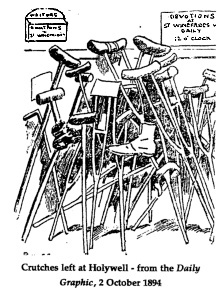
The exterior pool formed no part of the original building, being added later; but its size witnesses to the crowds of pilgrims who came even during the times of religious persecution. Nor was their faith in vain. For 800 years there is a continuous record of cures and other favours claimed at the Well through the prayers of St Winifred—the only British shrine boasting such an uninterrupted history of pilgrimage and healing. Until the 1960s, the crypt was stacked with crutches left by cured pilgrims. Centuries of letters testify to the power of God and His saints in this place: records of cures not only of Catholics, but of Protestants; and even of those with no faith in anything. One account, touching in its simplicity, a scrap of paper left at the Well 100 years ago, can stand for all the rest:
A Protestant Father wishes to return thanks to God that through the use of St Winifred's water, his only daughter was cured miraculously, Three years ago of a serious malady, which had resisted the efforts of several doctors & friends for the period of Three and a half years. Signed, C.T. Longley.
St. Winifred’s life compiled from various
sources
by Pravoslavie.ru/Orthodox Christianity
